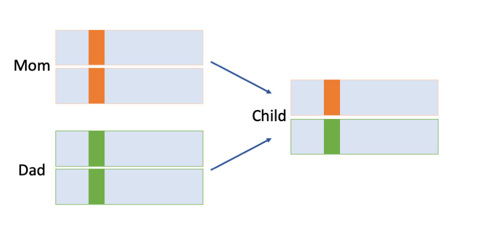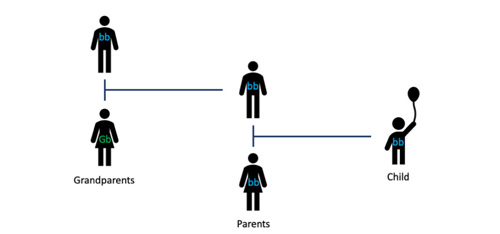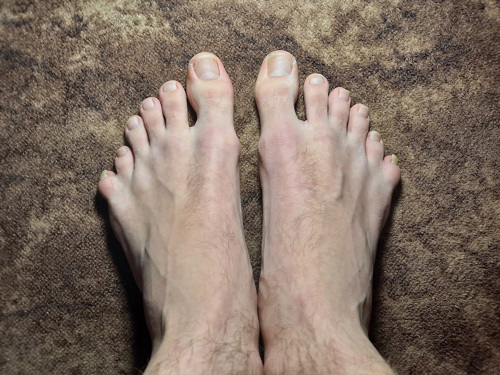
What role do grandparents play in the traits of their grandchildren?
January 5, 2012

A graduate student from New Jersey asks:
“I’ve always wondered what role a grandparent plays in the traits of his or her grandchildren. For example, I have blonde hair and blue eyes; my mother and father have brown hair and hazel eyes and black hair and blue eyes, respectively. What kind of effect would this have on my children? If, say, my wife was also blonde and blue-eyed, would it somehow lessen the chances of our children being blonde and blue-eyed?”
Yes, grandparents' genes can affect how their grandchildren look. After all, grandchildren get 25% of their genes from each of their grandparents. And genes have the instructions for how we look (and most everything else about us).
So your kids will definitely inherit some of your parents' genes. Which means they will inherit some of their looks too.
But obviously not every trait that your parents have will be passed down to your kids. Your kids won't be clones after all!
Their looks will come from the combination of genes you and your future wife happen to pass down to them. And these will have come from each of your parents. And so on through the generations.

So will your parents' dark hair or hazel eyes come out in your kids? Probably not because of how these traits work genetically.
If you didn't get your parents' darker hair and eyes, odds are they aren't lurking in your DNA waiting to re-emerge under the right circumstances. Blonde haired, blue eyed parents by and large have blonde haired, blue eyed kids.
But nothing in genetics is cut and dry. Some seemingly impossible genetics can and do happen sometimes. This means that your kids might get your grandparent's darker eyes or hair even if you have kids with someone with blonde hair and blue eyes. It just would be much less likely than blonde haired, blue eyed kids.
Hidden Traits
Like I said, our genes have the instructions for traits like eye and hair color. Each gene has the instructions for one small part of you. To see how it all works, let's focus on eye color.
Before diving into this discussion, we need to remember that we have two copies of most of our genes – one from mom and one from dad. Keep this in mind since it will be very important for everything that follows.
There is a gene that determines whether you will have blue or green eyes. For this discussion, we'll say that hazel equals green. This gene comes in two versions, green and blue. If you got a green version from mom and dad, you have green eyes. And if you got a blue version from each parent, you have blue eyes. But what if you got one of each? Then you have green eyes.

This is because green is dominant over blue (or you can say blue is recessive to green). All it takes is one green to have green eyes. And this is why it would be unlikely for you to have green (or hazel) eyed kids with a blue eyed wife.
But it is also why two green eyed parents can have a blue eyed child. And how blue eyes can skip generations.
We won't go into that here though. Let's instead focus on why your parents’ hazel eyes are so unlikely to appear in your children.
Lost Traits
So your mother has hazel eyes and your father has blue eyes. From our discussion above, we know that your dad most likely has two blue versions of the eye color gene. We'll call this version b. Your mom has at least one hazel/green version because she has hazel eyes. We'll call this version G.
What about the other copy of your mom's gene? Well, since you have blue eyes, we know you most likely have two blue copies (bb). And where did you get them? One from mom and one from dad. That means that your mom's other copy is probably a blue one (b).
If your future wife has blue eyes, she will also most likely have two blue copies of the gene (bb). As you can see from the family tree on the right, your kids will almost certainly have blue eyes too. This is because you each only have blue versions to pass on to your children.
That means that your kids will most likely all have blue eyes. So once dominant traits like dark eyes aren't passed on to the next generation, they can be "lost."

Found Traits
Well, it pretty much looks impossible for your kids to get your parents' eyes. But it isn't. Genetics is not nearly so "simple" as we have painted it.
Dominant traits like dark hair and dark eyes can sometimes skip a generation. Which means that sometimes a dominant trait is hidden even though it is dominant.
When dominant traits are hidden, we call it "incomplete penetrance." One example of a trait with incomplete penetrance is having extra fingers or toes. Most people with the version of the gene that leads to extra fingers will show the trait but some will not. Cleft chin is another dominant trait that can be hidden.
How do you hide a dominant trait? We don't know all the answers but sometimes a second gene can hide the dominant trait. And sometimes the environment can cause the dominant gene not to work as advertised until the next generation. For a detailed look at how cleft chin can skip a generation because of environmental factors and other genes, click here.
Eye color happens to be one of these traits too. Occasionally blue eyed parents will have a hazel or brown eyed child. Unfortunately because we don't understand the genetics yet, we can't easily predict when it will happen.
Incomplete penetrance isn't the only way for a dominant trait to skip a generation. Sometimes two people with a recessive trait have a child with a dominant trait because of a new change in the child's genes.

In this case, the genetic change wasn't passed on from the grandparents though. The child just happened to end up with a DNA change that gave the same eye color.
This sounds unlikely but it certainly happens for other traits. For example, a form of dwarfism called achondroplasia is usually the result of a new DNA change. In fact, in something like 7/8 cases of this form of dwarfism, both parents are of average height.
As I mentioned, this new genetic change isn't passed on from the grandparents. So technically if this happened, grandparents' DNA wasn't really influencing how this particular trait turned out in their grandkids. They both ended up with the same trait by different paths.
I don't want you to come away thinking these kinds of new changes are common. They're not. They have a pretty low chance of happening.
The chance that a new variant would result in a trait that matches Grandpa or Grandma's traits is pretty small too. Put these together and it's really unlikely that a trait would appear to skip a generation because of a new genetic change in a child.
So most of the time, dominant traits like dark hair and dark eyes don't skip a generation. But genetics is pretty complicated! That means that there's always a small chance that two blonde, blue eyed parents will have dark haired, dark eyed kids.

Author: Dr. Susan Roehl White
When this answer was published in 2012, Susan was a postdoctoral fellow in the Department of Molecular and Cellular Physiology, studying protein trafficking to primary cilia in Maxene Nachury’s laboratory. Susan wrote this answer while participating in the Stanford at The Tech program.
 Skip Navigation
Skip Navigation
